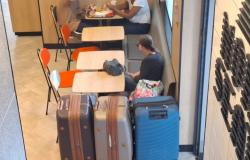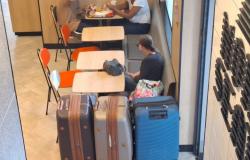The Uberaba geopark, known as Terra dos Gigantes, in the Triângulo Mineiro, was recognized as a global geopark by the United Nations Educational, Scientific and Cultural Organization (Unesco). The immense area collects research objects in the areas of paleontology and geology. With the new title, Brazil now has six globally recognized geoparks.
Geoparks are delimited geographic areas that have geological heritage of international relevance. The management of these territories aims to protect natural, historical and cultural heritage, in addition to promoting education, tourism and sustainable development.
This Tuesday (27), UNESCO recognized 18 new of these parks, which now total 213 in 48 countries. The UN body’s approval was obtained based on studies carried out by the Brazilian Geological Survey (SGB), which began in 2012.


The Uberaba Geopark, in Minas, obtains recognition from UNESCO – Photo Carlos Schobbenhaus/Disclosure
Dinosaurs
The Uberaba Geopark expands over 4,523.957 square kilometers, covering the entire municipality of Minas Gerais. In the region, fossils, teeth, eggs and litters of dinosaurs from the Late Cretaceous period have been found – estimated between 80 million and 66 million years ago.
One of the highlights among the finds are the bones of the Uberabatitan ribeiroithe largest dinosaur ever discovered in Brazil and one of the last titanosaurs (from the Latin titanic lizard) on the planet, measuring 27 meters long and 14 meters high.
According to the SGB, fossils of large theropod carnivores, such as Abelisaurus (Abelisaurus comahuensis), about eight meters tall, as well as crocodylomorphs, such as the Uberabasuchus terrificusexhibited at the Peirópolis Dinosaur Museum – which is located in Geoparque Uberaba.
“The uniqueness of this geopark and its geoscientific relevance are due to the fossils of dinosaurs and other species that were discovered at the site. There are geosites of paleontological interest, which can be visited and need to be geoconserved, as they were sites of fossil discoveries and can also reveal new discoveries”, explains geologist Carlos Schobbenhaus, one of the creators of the SGB Geoparks Project and co-author of the study that provided subsidies for the application dossier.
“A good part of the Earth’s history is represented in Brazil”, he adds.
The Terra dos Gigantes geopark brings together six geosites (Ponte Alta, Caieira, Univerdecidade, Serra da Galga, Santa Rita and Vale Encantado) and two non-geological sites (Dinosaur Museum and Museu da Cal).


The Uberaba Geopark, in Minas, obtains recognition from UNESCO. Uberabasuchus skull found in park – Photo André Borges Lopes/Disclosure
In announcing the new parks, UNESCO recalled that Uberaba is also known for its pioneering role in the introduction and breeding of zebu cattle, which “revolutionized the Brazilian agricultural market”.
Campaign
The group of archaeological sites in Uberaba has attracted paleontological research since 1940. In 2012, the SBG presented the study that served as the region’s candidacy dossier to receive global recognition by UNESCO.
In 2022, researchers visited the unit to complement the geological inventory and, in 2023, the Geological Heritage Map of the Uberaba Geopark – Terra dos Gigantes was published.
Geologist Luiz Carlos Borges Ribeiro, from the Federal University of Triângulo Mineiro (UFTM), is another co-author of the survey.
According to the Secretariat of Culture and Tourism of Minas Gerais, the recognition “projects Uberaba and the state into a new tourist route, in addition to generating more economic development, employment and income for the region”.
Another point highlighted by the secretariat is that the Unesco seal enhances the promotion of scientific research in relation to geological heritage and the appreciation of the cultural and historical heritage of the space.
Other geoparks


Uberaba Geopark, in Minas, obtains recognition from UNESCO – Photo UNESCO/Disclosure
In addition to Brazil, UNESCO’s decision this week recognized geoparks in China, Croatia, Denmark, Finland, France, Greece, Hungary, Poland, Portugal, Spain, Belgium, the United Kingdom and the Netherlands.
The other Brazilian geoparks are Seridó, in Rio Grande do Norte; Geopark Araripe, in Ceará; and the Caminhos dos Cânions do Sul, Quarta Colônia and Caçapava do Sul, all in Rio Grande do Sul.
The global geopark designation is granted for a period of four years. After this period, the regions go through a revalidation process, in which the functioning and quality of each unit are again evaluated.











